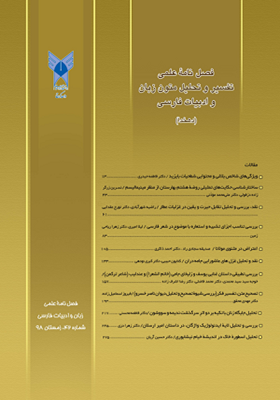تحلیل جایگاه زنان با تکیه بر دو اثرِ سرگذشت ندیمه و سووشون
محورهای موضوعی : متون زبان و ادبیات فارسی
1 - استادیار، واحد قزوین،دانشگاه آزاد اسلامی ، قزوین، ایران.
کلید واژه:
چکیده مقاله :
آثار ادبی، یکی از ابزارهای درک جایگاه و نقش زنان در جامعه است. از طریق آثار ادبی می توان به اوضاع و شرایط اجتماعی واقف شد که فراتر از خوانش رسمی و رایج هر دوره ای است. خصوصا اگر این آثار متعلق به دو جامعه ی متفاوت با دیدگاه ها و فرهنگ های متمایز از هم باشد. پژوهش حاضربر مطالعه دو اثر ادبی ندیمه مارگارت اتوود و سووشون سیمین دانشور متمرکز شده است تا ضمن بازنمایی جایگاه و نقش زنان در هر دو اثر، تفاوت ها و تشابه های هر دو نویسنده را به عنوان نمایندگان فرهنگ غرب و شرق واکاوی نماید. در زمینۀ حقوق، وظایف و مشکلات زنان هر دو مولف مشترکات فراوانی دارند، اما در عواملی چون عدم رعایت حقوق زنان و نقش ساختارهای فکری و فرهنگی در ایفای وظایف و استیفا حقوق زنان، تفاوت های مشهودی به چشم می خورد چنانکه نگاه جهانی تر و عام تر جامعه ی غربی در تقابل با نگاه محدودتر و سنتی تر جامعه ی شرقی به زن قرار می گیرد. نگارنده در نوشتار حاضر ضمن بازخوانی آثار ندیمه و سووشون، اهتمام دارد به روش توصیفی- تحلیلی (کتابخانه ای) ضمن پرداختن به موضوع جایگاه زن ، تمایزها و علل آن را،در این دو اثر واکاوی می نماید.
Literary works are one of the tools for understanding the status and role of women in society. Through literary works, it is possible to understand the social conditions and circumstances beyond the formal reading of each period. Especially if these works belong to two different societies with different perspectives and cultures The present study focuses on the study of two works of Margaret Atwood's and Nedous's literary works, Simon Daneshvar, in order to present the differences and similarities of both writers as representatives of the culture of the West and the East while presenting the position and role of women in both works Concerning the rights, duties and problems of women, both authors share common ground, but there are significant differences in factors such as the lack of respect for women's rights and the role of intellectual and cultural structures in the performance of their duties and in the pursuit of women's rights, as the broader and more general view of Western society in Contrary to the narrower and more traditional orientation of the Eastern community to the woman. The author of this article, while recounting the works of Neda and Soushoun, is trying to find out the distinctions and causes of this work in a descriptive-comparative (library) way.
مقالات
_||_

